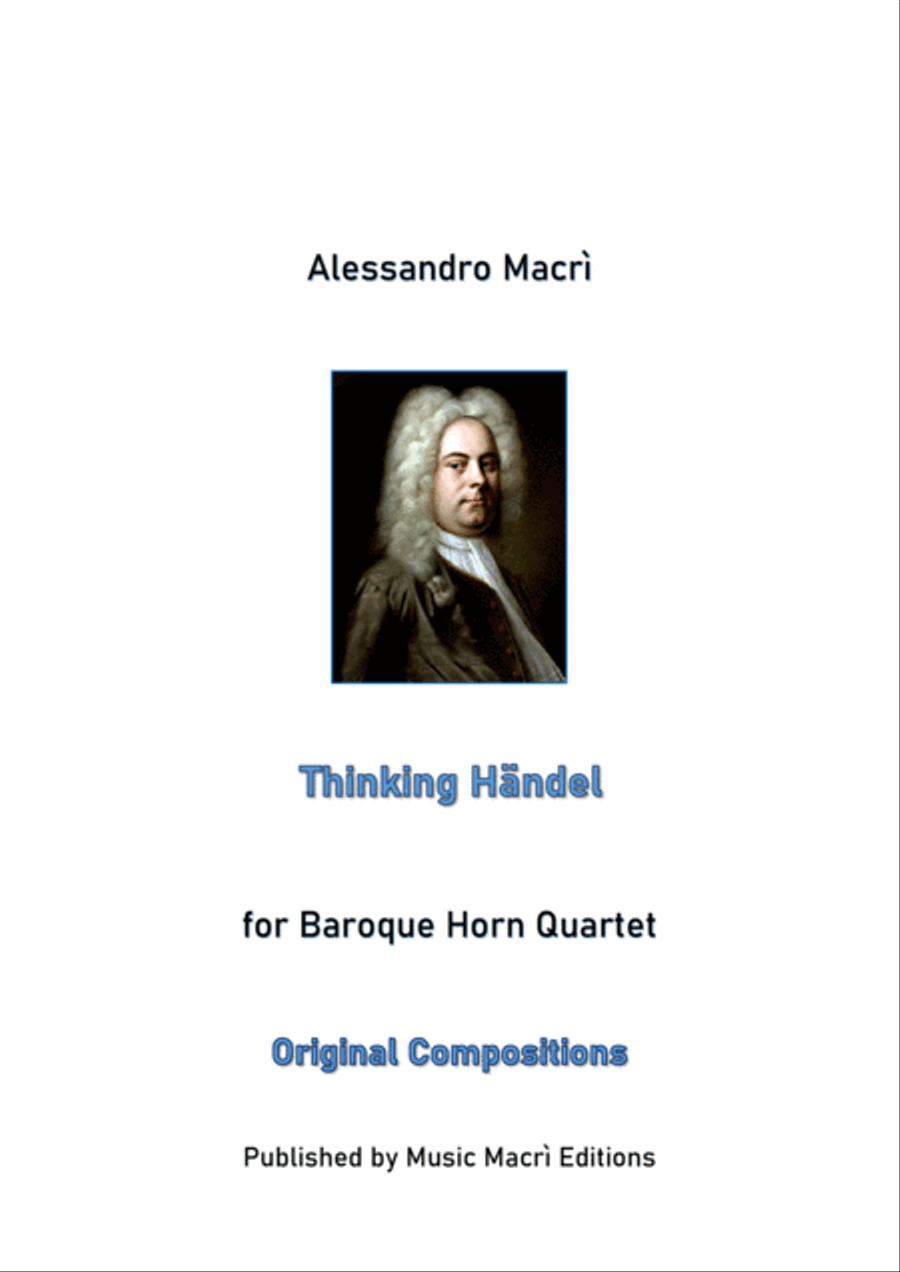Brass Ensemble Horn - Level 2 - Digital Download SKU: A0.931276 Composed by Alessandro Macr√¨. Baroque,Classical,Concert,Instructional,Standards. Score and parts. 10 pages. Music Macri Editions #6082045. Published by Music Macri Editions (A0.931276). Thinking H√§ndel √® un tributo al grande compositore Georg Friedrich H√§ndel, coetaneo di Johann Sebastian Bach, che fu tra i pi√Ļ illustri rappresentanti del barocco musicale. Scrisse opere, oratori e musica strumentale, assimilando gli stili del Settecento che fuse in una sintesi personale e unitaria.I primi successiH√§ndel nacque nel 1685 a Halle, in Germania, da una famiglia senza tradizioni musicali. Inizi√≤ da bambino lo studio della musica, dimostrando subito un grande talento come compositore e organista. All'universit√† di Halle intraprese anche studi giuridici. Nel 1703 si stabil√¨ ad Amburgo, dove lavor√≤ come violinista e dove ebbero luogo le prime esecuzioni di sue musiche, tra cui l'opera Almira, regina di Castiglia (1705).Negli anni successivi comp√¨ diversi viaggi in Italia, in Germania e a Londra, dove nel 1711 fu rappresentata con grande successo la sua opera Rinaldo. Nonostante sia oggi conosciuto soprattutto per gli oratori e la musica strumentale, ai suoi tempi H√§ndel fu molto apprezzato per le opere teatrali, prevalentemente composte secondo il modello dell'opera seria italiana (forme musicali). Ambientata in epoca classica, di argomento letterario o di ambientazione mitologica, l'opera seria alterna, in lingua italiana, recitativi e arie. I recitativi, con un'intonazione vicina alla lingua parlata, servivano a far procedere l'azione ed erano accompagnati dal cembalo e a volte dall'orchestra. Le arie, con intonazione melodica, avevano la funzione di esprimere gli stati d'animo o 'affetti' dei personaggi e in esse i cantanti mostravano la propria virtuosistica bravura.Al tempo del soggiorno londinese risalgono anche due significative composizioni orchestrali: le tre suite Musica sull'acqua (1715-36), nate per accompagnare le feste sul Tamigi di re Giorgio I, e i Sei concerti grossi op. 3 (1730-34), ispirati al modello del musicista italiano Arcangelo Corelli.La cittadinanza ingleseNel 1719 H√§ndel promosse la fondazione di una societ√† musicale privata, la Royal academy of music, e ne divent√≤ direttore. Nel 1727 ottenne la cittadinanza inglese e per molti anni domin√≤ la scena musicale britannica. Oltre alle circa quaranta opere teatrali, tra cui Giulio Cesare in Egitto (1723), Rodelinda regina de' Longobardi (1725), Ariodante (1734), Alcina (1735), Serse (1737-38), in questi anni scrisse pi√Ļ di venti oratori ‚Äí composizioni di argomento religioso, per soli, coro e orchestra ‚Äí in forma drammatica e in lingua inglese (con narrazione, personaggi e dialogo ma senza scena teatrale), per lo pi√Ļ con testi tratti dall'Antico Testamento (tra cui Esther, 1718, Saul e Israele in Egitto, del 1738 entrambi).L'adesione di H√§ndel alla cultura inglese non fu occasionale, ma profondamente sentita: lo dimostrano alcuni lavori vocali e strumentali, come Acis e Galatea (1718, con una seconda versione nel 1732) e l'Ode per il giorno di s. Cecilia (1739), composti su testi di poeti inglesi di grande rilievo come John Dryden e Alexander Pope.Tra la musica strumentale, H√§ndel dedic√≤ in particolare all'organo, di cui era valente esecutore, ben venti concerti con orchestra.Il Messia e le ultime composizioniL'oratorio Messia √® uno dei lavori pi√Ļ conosciuti di H√§ndel: eseguito a Dublino nel 1742, fu scritto per una istituzione benefica in soli ventiquattro giorni. Il libretto di Charles Jennens, in inglese, illustra in tre parti i momenti pi√Ļ rilevanti della vita di Cristo con brani delle Sacre Scritture (√® l'unico oratorio tratto dal Nuovo Testamento). La prima parte tratta dell'Avvento e del Natale; la seconda della Passione e della Resurrezione, culminante nel celebre Halleluja; la.
